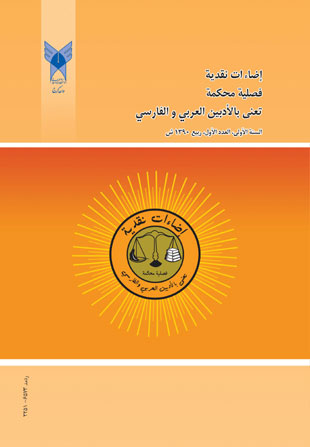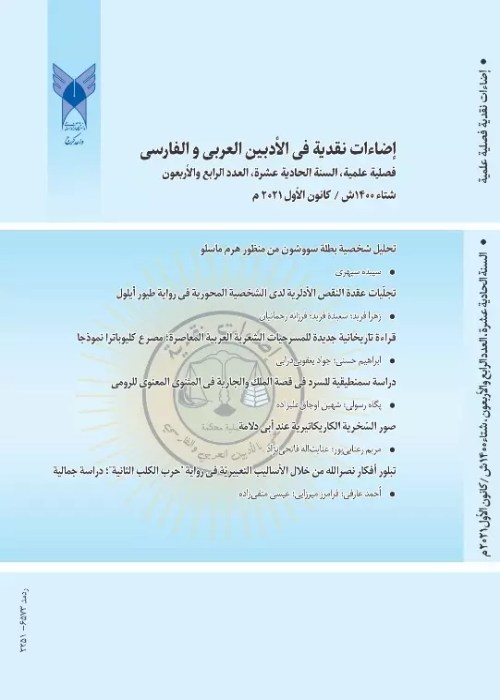فهرست مطالب

فصلنامه إضاءات نقدیه فی الادبین العربی و الفارسی
پیاپی 1 (ربیع 2011)
- تاریخ انتشار: 1390/02/15
- تعداد عناوین: 8
-
-
صفحات 31-56
-
صفحات 57-74
-
صفحات 75-87
-
صفحات 143-153
-
Pages 9-29Renewal or innovation in literature means changes in the literature in order to become concurrent with the transformation of social relations in an appropriate way thus organized to take the necessary and proper form. So for every poet and writer it is a must to strive to be aware of the spirit of his age thus interpreting it correctly. In addition to imitate predecessors, Neo-Classical poets took steps to recapitulate the rules and themes in ancient poetry. The secret behind the continuation and renewal of the Neo-Classical school is imitation in form and innovation in content or theme. This article examines the common and new themes of New Poetry in Persian and Arabic Neo-Classical schools based upon poetry of undisputed representatives of the two schools, namely, Mohammad Taqi Bahar, Ahmed Shawki.In this study, many common themes were found between these two schools which indicate that there are common cultural, social and political commonalities between Arabs and Iranians.Keywords: Modernism, Neo, Classic, Shawki Themes, Baha
-
Pages 31-56
Graduated Student from Islamic Azad University, Karaj Branch“The Diaries of Prosecutor’s Representative in the Village” is, nodoubt, one of the most prominent works ever written by Tawfiq Hakim,the contemporary Arab novelist. The proof to this claim can be the factthat the novel has been translated into many other languages, and usedas the basic plot for different movies.In this novel, Tawfiq Hakim, illustrates aspects of Egyptian life witha focus on rural areas. This article aims at reviewing narrative elementsof this novel’s story such as setting, time, character, dialogue, and plot.The story occurs at a place called “al-vajh al-ghabali” during twelvedays of October although the writer tries not to restrict the story line toa specific time span.The author tries to depict characters through their reactions towardthe events, which begin with a gunshot.
Keywords: Tawfiq Hakim, the novel, time, place, Egypt -
Pages 57-74M.A. of Arabic Language & Literature, Tarbiat Moallem UniversityThe Egyptian poet, Ibin Nobatah is one of the most renowned poets ofMamluki era who, we may say, has complained about different issues inhis poetry much more than his contemporary poets. In these complainingpoems he has considered issues like life and death, separation andpoverty, old age and common maladies in the world surrounding him.But the present article emphasizes the poet’s attention for the artisticfeatures which have paved the way for him to express his complaints andexpress a better articulation for his private pains. The important featurescan be pointed as the poet’s use of words, compositions and styles and acombination of rhythmic diction compatible with his complaint and thedepressing atmosphere surrounding him.Keywords: Ibin Nobatah, complaints, artistic, technical features, poetic diction, compositions, style, rhythmic diction
-
Pages 75-87Bidel Dehlavi as the greatest mystical poet in the Indian Subcontinenthas unleashed the Indian School of Persian poetry from its formalform and style. To him the sonnet was the continuation of the thoughtsand ideas of Mowlavi’s in his ‘Shamsiyaat’. The present article is anattempt to come to an understanding of Bidel through the lens of hismystical sonnets where he upholds the idea that, in the process of themystical return a human being takes, all the forms of multiplicitydirect themselves towards a direction of unity. All those forms in theirdownward waft from the creator to the created are representationalwhich confer and illustrate the characteristics of the Creator. Themystical sonnets of Bidel dramatize a mystical epic which renders thelove of a human being for his eternal beloved. These sonnets frequentlycarry surreal layers of meaning in themselves thus making the poeticvocabulary he uses in his depiction of such a mystical expressions quiteperplexing to the readers as well as the researchers. All these said, hispoetry bears such an enthusiasm and attraction in itself that his use ofsuch meter and feet, rhythm and rhyme has all made it more invitingand effective to the readers.Keywords: Bidel Dehlavi, mysticism, mystical sonnets, Indian School in Persian poetry, pantheism
-
Pages 89-108‘The Literary Garden’ is a collection of thirty three anecdotes in the form of masnavi. The poet uses simple and commonplace vocabulary in these poems since using simple diction in those works addressing children plays an important role. Meanwhile, the poet avoids using colloquial and vernacular diction lest making children used to them therewith arriving at his didactic end in increasing the vocabulary range of children reading these poems. The poet imbues a formal and classical sense in these poems to provide a serious tone in them all in a way that - except a poem named ‘Asl’aan’ – no sign of political or social satire can be found. Therefore, in the first place, these poems are didactic and the poet has not used them to metaphorically imply hints to the political, social and religious conditions of his time.Keywords: Nasim, e, Shomal, Children's Literature, The Literary Garden', Comparative Literature
-
Pages 109-124Comparative literature is one of the major branches of literature, in which the researcher surveys on the works of two poets who enjoy different literature and after identifying of the differences and similarities between both of them, their poems and proses are compared. This leads to unity of culture between two nations and also the great literary men are mostly recognized. In this research, sufi-lyrics of two eminent poets, Ibne Farez and Jami, have conceptually been investigated since both are considered the pioneers of sufi verse between Arab and Persian. This research first deal with the biography of two poets and then their poems are conceptually surveyed based on the most significant symbols of sufi verse such as wine and woman that is used as the mystery of verse by poet in order to express his spiritual goal and mystical purpose.Keywords: Ibne Farez, Jamie, Sufi, lyric, Love, Wine, Woman
-
Pages 125-141Graduated Student from Islamic Azad University, Jiroft Branch Researches done on Mowlana’s and Hafez’s poems abound in numbers leaving the readers with the idea that no other concept has beenleft unexplored. But once all these researches re-examined, one finds that a part of the Iranian and Islamic literature has not been thoroughly explored and explained by the researchers in the field. This is where we come to the Arabic poems composed by these two poets which in themselves exemplify their poetic craftsmanship as well as their mastery, especially Mowlana, of the Arabic language. After a-examination of the poetry of these two great poets one comes to the conclusion that they take their philosophical sustenance from the teachings of Quran. This is apparently detectible through the liens of all these Arabic poems which reflect the impact of the Abasid era literature on them using a very simple and down to earth language and bearing the vast power of imagination and some motives of Arabic poetry. This article is an attempt to compare the Arabic poems composed by Mowlana and Hafez and, through a new perspective, present these two poets in different dimensions and perspectives which have not been explored therewith informing the readers who have not been acquainted with them by examining their mutual spiritual experience they both provide.Keywords: Jalal ad, Din Muhammad Rumi, Hafez, Sonneteer craftsmanship in Arabic poetry, commonalities in diction, meaning, Sufism, adaptation, having impact on, getting impact from.
-
Pages 143-153Islamic Azad University North Tehran Branch Comparative Literature is a kind of literary researches that born in france and grew up then expanded at the second half of the twentieth century in third world universities. Comparative literature in its simple and primary concept is very old.the aim that we consider in this research is comparative literature in its causative concept in Iranian universities. Comparative literative was established by the efforts of lady fatemeh sayyah in Iran and in researches of competent scholars like Dr Mohammad mohamadi and jawad Hadidi and Azartash Azarnoush culminated. But this academic unit has faced a huge number of challenges such as severe lack of know ledgeable teachers and inatten tion to theory of comparative literature. This study is an attempt to provide a picture of the history of comparative literature in Iran and its encountered challengesKeywords: comparative literature, the first comparatistes in Iran


